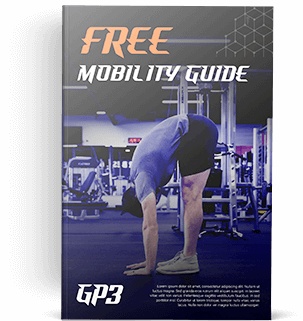Key Points:
1. Pain alters movement patterns. These adaptations can linger and trigger pain long after any structural damage associated with an injury has fully healed.
2. “Neuromuscular re-education” is a process by which we can retrain our brains and nervous systems to stop causing pain due to perceiving certain movements as threatening.
3. When consistently done at appropriate levels of intensity, neuromuscular re-education can help us permanently overcome even decades-old pain.
Estimated reading time: 5-10 minutes
Listen to this article on Spotify!
Last week, defining pain was our primary focus. We classified it at as two things:
- Sensations of varying intensities
- A message from our nervous system that a threat has been detected
I promised that this week’s piece would focus on what I’ve found to be the best tool in our arsenal for overcoming pain, a concept called “Neuromuscular Re-education.” Before we dive more deeply into that, however, let’s quickly examine traditional methods of addressing pain. I also want to be clear that this article refers to pain traceable in some way to an injury, not chronic health conditions. Those can be much more complex. With that, let’s get to it, shall we?
Masking Pain
Typically, we focus on “pain-killing” solutions that aren’t actually solutions. Drugs and injections focus on symptoms but don’t address what’s causing pain. They change the sensations so that we no longer experience discomfort. But because the underlying issue hasn’t been fixed, our nervous systems are going to find another way to send us a message. Ignore the brain for long enough, and it speaks louder and louder.
What’s more, these “sensation-masking” solutions can lead to us pursuing the very activities that our brains are trying to convince us to avoid. For example, if my ankle hurts when I run, my brain is telling me not to run. In such a case, I would need to address the strength, mobility, and stability of my feet, ankles, and lower leg muscles before I can run again.
The absolute last thing I should do is pop a bunch of Advil and run anyway. That is guaranteed to cause further problems, until I’m eventually forced to stop. So, what should we do instead of masking pain?
Enter: Neuromuscular Re-education
Broadly, this can be defined as teaching our brain and nervous system that painful movements are safe. How do we do this, you ask? Well, specific treatments are unique to each injury and thus outside the scope of this piece, but I want to make sure you’re familiar with the concept itself. To that end, we need to revisit something we covered last week, the brain’s perceptions of threat. If speed, position, and load are the primary mechanisms that trigger a threat response and thus, pain, neuromuscular re-education starts by utilizing degrees of each that don’t do that.
One of the first topics I wrote about, short and long range training, comes in very handy here. Short range movements work muscles at or near their maximally contracted positions, which has the following key benefits:
- Massively increased blood flow to target areas
- Minimal tissue damage
- Very little stress on connective tissue like tendons and ligaments
- Improved neural control, which is also known as the “mind-muscle connection”
The first three bullet points can help strengthen a sensitive area of the body without much risk of pain or soreness the next day. But it’s the fourth bullet point that we’re most concerned with when it comes to neuromuscular re-education.
You see, when the brain detects threat in an area, it inhibits the surrounding muscles from firing. It does this to discourage us from using them, decreasing the likelihood that we’ll expose the body to movements, speeds, and loads that it perceives to be unsafe.
This works well in the short term, but can have drastic consequences in the long term. To help understand the knock-on effects better, I spoke to a manual therapist in the Phoenix area with over 30 years’ experience. Allow me to paraphrase what he said:
“Let’s say you need to scratch the side of your head. Under normal circumstances, you’d just lift your arm and do it. But now let’s say you injured your shoulder and it hurts to lift your arm. You might tilt your head to the side so that you don’t need to lift your arm as high. After only four weeks, this becomes your new normal, and you’ll continue to scratch your head this way long after the shoulder has healed. If you don’t change anything, you might scratch your head that way for the rest of your life.”
So, when do we respect pain?
As I mentioned in last week’s piece, we should absolutely be respectful of pain from an acute injury. But, let’s say a joint has been giving us pain for over a year. At this point, all of the tissue healing that’s going to take place has likely already occurred.
Take my back injury, for example. The double fracture happened in 2009, yet if we scanned it today, one side would still show visible damage. The same goes for the torn labrum in my left hip that occurred in 2017. And yet, except for extremely rare occasions, I have no pain even with strenuous activity. In these rare instances of pain, a couple days of rest and mobility work has me feeling good as new.
In cases where injuries are years old but we still have discomfort, we need to undergo a patient but deliberate process of showing the brain that it doesn’t need to be on high alert all the time, and doesn’t need to send the pain signal. That’s the crux of neuromuscular re-education.
But, we usually try this the wrong way.
I think our typical approach to addressing injuries is backwards. We try to be active when we should be passive, and passive when we should be active. To clarify, we’re often impatient and want to be overly involved in the early stages of recovery, but not enough in the latter ones. Here’s a common example. I’ll hear people say things like, “I got kicked in the ankle pretty hard during practice last night and it really hurts this morning. What stretches or exercises can I do to get rid of the pain?”
This is akin to saying something like, “I sliced my finger while chopping vegetables for dinner last night. How do I make the cut scab faster?”
We know that we can’t do much in the latter case, so we don’t try. We apply ointment and a bandage, then leave it alone and let the body work its magic. With regard to acute injuries, I talk more about what we can actually do in this article. But let’s get back to the point.
Once the acute healing stage of an injury has passed, if pain is still present, we often switch into a passive, defeated state of acceptance. “Well…I guess I just have a bad knee now.” Wrong!
THIS is the time to take an active role in our rehabilitation.
As a quick digression, surgery is a last-resort solution! People often think that if they just undergo surgery in the area causing their pain, the problem will be solved. But, it takes six to twelve months at a minimum for the inflammation from a surgery to fully subside. Often longer.
Don’t get me wrong. There are absolutely cases in which surgery is necessary. But, unless something needs to be reattached or removed, don’t be so quick to hop under the knife, even if imaging makes surgery look like such a decision would be warranted. I love the example of Major League Baseball pitchers highlighted in this study, where most had structural abnormalities that led to orthopedists recommending surgery in a blind test. But…none of these athletes had pain. Their scans simply didn’t match the expected “normal.”
Instead, the best approach is to utilize neuromuscular re-education to get ourselves out of pain.
We do this by first finding ways to activate the muscles around the previously-injured area without triggering a pain response. Initially, this may be as minimal as gently massaging the area to increase blood flow, or engaging in non-weight-bearing movements, like making ankle circles if we have Achilles pain.
Over time, our job is to gradually push the envelope. While still avoiding exercises that make pain worse, we can start adding speed and load while moving into ever more challenging long range positions. We can do this by using methods like Repeated Antagonist Contractions, compression flossing, or an NMES device like the Neubie.
Making the Brain Recalculate
Here’s one of my favorite examples to illustrate the need for neuromuscular re-education. Imagine you were in a pitch black room and someone told you to sprint as fast as you could to the other side. No matter what, you wouldn’t be able to run as quickly as you would outside in the light. Your brain simply won’t let you. When we don’t have as much sensory information coming in, the brain is more cautious. It holds us back.
I want to reiterate that this a deep evolutionary survival mechanism, subconscious and uncontrollable. But, the same thing happens with old injuries and muscles that the brain has inhibited from proper activation for more than four weeks. It simply won’t allow them to work to their full capacity.
However, when we can increase the amount of sensory information coming in, or provide the nervous system with novel stimuli, the brain takes notice. When old, painful patterns are interrupted, the brain is forced to recalculate what it had previously perceived as threatening. When this increase or change in sensory input is present, pain-free output is the result. To return to the above example, Neuromuscular re-education is the equivalent of flipping the lights back on so you can run through a previously dark room.
Even better, if we repeat this process of retraining the brain, it’s possible to permanently overcome pain, regardless of how serious the initial injury or how long you’ve been in pain. Pretty darn cool, huh? So, if you’re on a rehabilitation journey, keep your eyes and ears peeled for practitioners of neuromuscular re-education. It could be exactly what you need.
Before you go, I’d love to hear from you. Do you have any areas that have given you pain for years? What are they? Have you heard of neuromuscular re-education and would you be open to trying it? Reply to this email and let me know!

